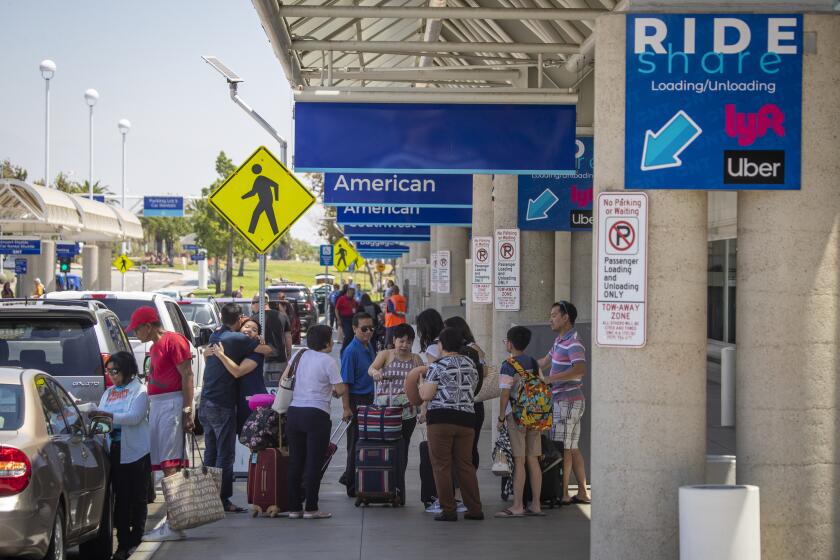Working out 2,000 details of a merger
Continental Airlines serves Angus cheeseburgers on its flights. United Air Lines doesn’t even have the right ovens to heat them.
United loads passengers in window seats first. Continental boards from the back. And United has a specific way to load dogs onto a plane -- always tail-first as they ride up the conveyor belt in carrier cages. On Continental, there’s no strict policy.
These are just three of the thousands of differences in the daily practices and policies of United and Continental airlines. But soon they will have to act as one.
The two airlines are close to completing a $3-billion merger that next year will create the nation’s largest carrier, with more than 86,000 employees and nearly 1,200 jets. Federal regulators approved a final clearance to the merger this week.
But over the last year and a half, a team of managers and staff from the two carriers has made about 2,000 decisions about how the new hybrid airline will operate. The trick has been trying to preserve the most popular practices of each without alienating devotees of either.
One merger decision -- whether to have a fleet-wide audio channel to let passengers hear pilots talk to air traffic controllers -- even sparked an online campaign by fans of the channel.
“If the acquiring airline has an open mind, it will examine both carriers’ business practices and pick those that offer a combination of better service for the traveler and improved savings or efficiency for the airline,” said Henry Harteveldt, co-founder of Atmosphere Research Group, a San Francisco travel marketing and technology research firm.
It’s a time-consuming process. When Delta Air Lines merged with Northwest Airlines last year, airline officials said they had so many decisions to make that they started by writing the topics on yellow Post-it notes that covered an entire wall.
“It only made sense that they would do that,” said Bob McAdoo, an airline analyst for Avondale Partners in Nashville. “That is the kind of stuff that makes a merger work.”
Airline executives from Delta and Northwest opted to keep the Delta name but adopted some of Northwest’s most popular menu choices in the first-class section, including adding Twix candy bars and fresh fruit. It also adopted Northwest’s policy of offering pretzels in coach.
When United and Continental begin to operate as one, the new airline will fly with United’s name but with Continental’s globe symbol and a new motto -- “Let’s Fly Together.”
In weighing which system of boarding passengers to use, airline executives chose the United method. Post merger, customers with window seats will be first to get on the plane, followed by those in middle seats and finally passengers in aisle seats.
Industry studies have shown that the United process reduces boarding time, allowing the airline to squeeze in more flights per day.
On the other hand, the new airline will adopt a Continental policy that gives current employees priority over retired workers when waiting to fly coach on standby.
Some policy changes are made in response to customer feedback. United officials say they routinely review thousands of online surveys taken by passengers.
“We have a lot of data,” said Rahsaan Johnson, a spokesman for United Continental Holdings, the Chicago company that owns both carriers. “We know what people say they like.”
The new airline will adopt Continental’s policy of offering early boarding to active-duty members of the military traveling in uniform and Continental’s practice of offering free alcoholic drinks at the airline’s new members-only airport lounges, to be dubbed United Club.
The new merged airline will also sell a snack box that contains some of the most popular food sold on both airlines, including Pepperidge Farm Goldfish crackers and Oreo cookies.
Practical matters, such as cost, have prompted other changes. Continental’s Angus cheeseburgers, a passenger favorite served on domestic flights, will not survive the merger because United’s planes are not equipped to heat up the patties.
Soon after the merger was announced, Jeffrey Smisek -- formerly the chief executive of Continental and now the CEO of United Continental Holdings -- said it was too expensive to expand to all planes an onboard channel that lets passengers listen in on cockpit conversations.
Fans of Channel 9 protested by creating a Facebook page, writing letters to Smisek and sending Twitter messages in support of the channel expansion.
“My kids and I both love Channel 9,” said Jorge Flores, a United passenger from Los Angeles. “By listening in on ground control one can anticipate any type of chop that may be ahead and know how long it will last.”
In August, Smisek agreed to expand Channel 9 to the entire fleet after the airline’s maintenance crew found they could cut the installation costs by doing the work in conjunction with other maintenance work.
“We are expanding Channel 9 because customers like it and because we determined we can do it cost-effectively,” Johnson explained.
And as for those dogs, there will be no more choice on the part of baggage handlers. United has won out on this one -- when the merger is completed, all pets will be riding into the plane tail-first.







